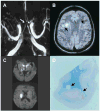Clinical and molecular aspects of varicella zoster virus infection
- PMID: 19946620
- PMCID: PMC2782836
- DOI: 10.2217/14796708.4.1.103
Clinical and molecular aspects of varicella zoster virus infection
Abstract
A declining cell-mediated immunity to varicella zoster virus (VZV) with advancing age or immunosuppression results in virus reactivation from latently infected human ganglia anywhere along the neuraxis. Virus reactivation produces zoster, often followed by chronic pain (postherpetic neuralgia or PHN) as well as vasculopathy, myelopathy, retinal necrosis and cerebellitis. VZV reactivation also produces pain without rash (zoster sine herpete). Vaccination after age 60 reduces the incidence of shingles by 51%, PHN by 66% and the burden of illness by 61%. However, even if every healthy adult over age 60 years is vaccinated, there would still be about 500,000 zoster cases annually in the United States alone, about 200,000 of whom will experience PHN. Analyses of viral nucleic acid and gene expression in latently infected human ganglia and in an animal model of varicella latency in primates are serving to determine the mechanism(s) of VZV reactivation with the aim of preventing reactivation and the clinical sequelae.
Figures




Similar articles
-
Neurological disease produced by varicella zoster virus reactivation without rash.Curr Top Microbiol Immunol. 2010;342:243-53. doi: 10.1007/82_2009_3. Curr Top Microbiol Immunol. 2010. PMID: 20186614 Free PMC article. Review.
-
Varicella Zoster Virus in the Nervous System.F1000Res. 2015 Nov 26;4:F1000 Faculty Rev-1356. doi: 10.12688/f1000research.7153.1. eCollection 2015. F1000Res. 2015. PMID: 26918131 Free PMC article. Review.
-
Varicella virus-mononuclear cell interaction.Adv Virus Res. 2003;62:1-17. doi: 10.1016/s0065-3527(03)62001-4. Adv Virus Res. 2003. PMID: 14719363 Review.
-
Varicella zoster virus latency, neurological disease and experimental models: an update.Front Biosci. 2004 Jan 1;9:751-62. doi: 10.2741/1275. Front Biosci. 2004. PMID: 14766405 Review.
-
Exploring the Potential Stimuli and Deterrents of Varicella-Zoster Viral Reactivation: A Scoping Review.Cureus. 2025 Mar 31;17(3):e81491. doi: 10.7759/cureus.81491. eCollection 2025 Mar. Cureus. 2025. PMID: 40308434 Free PMC article. Review.
Cited by
-
Nectin-1 Is an Entry Mediator for Varicella-Zoster Virus Infection of Human Neurons.J Virol. 2021 Oct 27;95(22):e0122721. doi: 10.1128/JVI.01227-21. Epub 2021 Sep 1. J Virol. 2021. PMID: 34468169 Free PMC article.
-
Effectiveness of continuous epidural analgesia on acute herpes zoster and postherpetic neuralgia: A retrospective study.Medicine (Baltimore). 2018 Feb;97(5):e9837. doi: 10.1097/MD.0000000000009837. Medicine (Baltimore). 2018. PMID: 29384888 Free PMC article.
-
Longitudinal Extensive Transverse Myelitis in an Immunocompetent Older Individual-A Rare Complication of Varicella-Zoster Virus Reactivation.Medicina (Kaunas). 2019 May 23;55(5):201. doi: 10.3390/medicina55050201. Medicina (Kaunas). 2019. PMID: 31126152 Free PMC article.
-
The Role of the Microbiota in the Diabetic Peripheral Artery Disease.Mediators Inflamm. 2019 May 8;2019:4128682. doi: 10.1155/2019/4128682. eCollection 2019. Mediators Inflamm. 2019. PMID: 31205450 Free PMC article. Review.
-
Animal models of varicella zoster virus infection.Pathogens. 2013 May 13;2(2):364-82. doi: 10.3390/pathogens2020364. Pathogens. 2013. PMID: 25437040 Free PMC article. Review.
References
Bibliography
-
- Harnisch JP. Zoster in the elderly: Clinical, immunologic and therapeutic considerations. J Am Geriatr Soc. 1984;32:789–793. - PubMed
-
- Donahue JG, Choo PW, Manson JE, Platt R. The incidence of herpes zoster. Arch Intern Med. 1995;155:1605–1609. - PubMed
-
- Gilden DH, Cohrs RJ, Mahalingam R. Clinical and molecular pathogenesis of varicella virus infection. Viral Immunol. 2003;16:243–258. - PubMed
-
- Leppard B, Naburi AE. Herpes zoster: an early manifestation of HIV infection. Afr Health. 1998;21:5–6. - PubMed
-
- Kakourou T, Theodoridou M, Mostrou G, Syriopoulou V, Papadogeorgaki H, Constantopoulos A. Herpes zoster in children. J Am Acad Dermatol. 1998;39:207–210. - PubMed
Websites
-
- U.S. Census Bureau. US interim projects by age, sex, race, and hispanic origin. 2004. http://www.census.gov/ipc/www/usinterimproj/natprojtab02a.pdf.
-
- National Center for Biotechnology Information (NCBI) 2008. http://www.ncbi.nlm.nih.gov/sites/entrez.
Grants and funding
LinkOut - more resources
Full Text Sources
